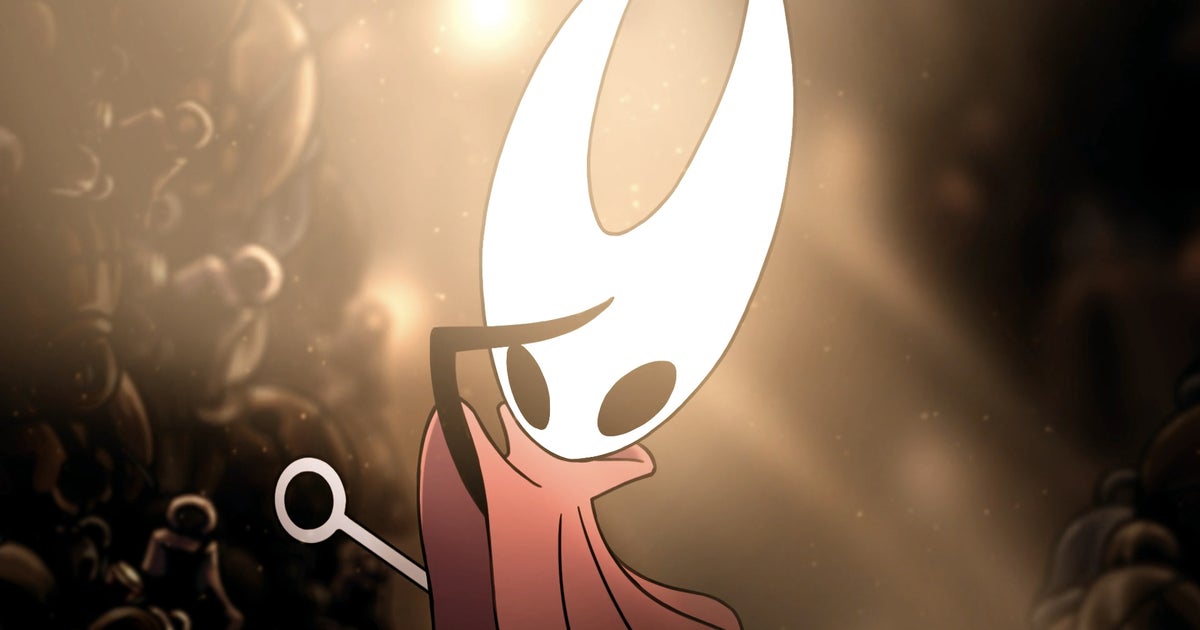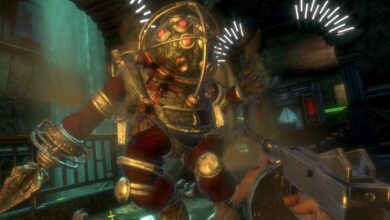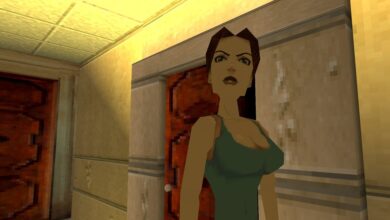Hollow Knight: Silksong review – beautiful, thrilling and cruel

Pretty and charmingly mean-spirited, this is a game filled with revelations and genuine personality.
Metroidvanias are the games where I’m allowed to get stuck in several places at once. Head upwards and there’s a boss that I can’t beat. Try going down the stairs instead and there’s an environment that kills me just for stepping into it. Left and right are dead ends that I don’t have the tools to navigate yet. Stuck on all four points of the compass! That’s a Metroidvania.
Hollow Knight: Silksong is a Metroidvania. It’s a Metroidvania with rare poise and – this is crucial, even after a recent patch – a fearsome sense of conviction. It casts you as an elegant and swift-spirited bug, a hornet, who’s been kidnapped and left to explore the kind of close-up worlds of wonder and horror that Robert Hooke once revealed with his microscope. What a place, or series of places! Down in the moss and dewy earth, the merest ant is suddenly a monster, while a bedbug is a hulking battletank bristling with weapons, and bristling with bristles.
Let’s pause here for a second, before the carnage begins, and just ponder how beautiful this hand-drawn universe is. Here are grottoes, caverns, and passageways carved from the living earth. Here are complex factories filled with spinning saw-blades and steam vents, and abandoned coastal towns scaled for inhabitants no bigger than the lint that gathers at the bottom of your pocket. Here are cursed churches and battlements and palace attics and whole communities that seem to live inside addled jewelry boxes, their streets encrusted with loose gems and shards of copper and solder, the mineral air thick with petals and pollen. All of this complemented by a score that’s haunted, playful, and endlessly beckoning: the perfect soundtrack for a collection of spooky short stories you’ve stumbled across by accident in a wonky old bookstore.
It’s all filled with life, too. As with the first Hollow Knight, Silksong’s world is fairly rattling with shopkeepers and cartographers and all kinds of neglected artisans and explorers. They’re filled with charm, and the art style’s fully able to switch things up from one area to the next. All of this without warping the game’s own sense of internal coherency. There’s always something of Mucha to the swoop and curve of branch and brass in this place. There’s always something of Méliès to the flickering world and its alien inhabitants, all glimpsed a touch more sharply in the gentle iris of grainy light that surrounds the hero. If there was ever a game to play on a magic lantern, it’s this one.
This is all artful stuff, in other words, and sure enough there is an art to everything in Silksong. Even, since this is a Metroidvania after all, to the act of being stuck. So let’s talk about getting stuck. It’s a big part of Silksong, for a player of my abilities at least.
Here’s what I’ve learned over the last week: you have to learn how to get the most out of being stuck in Silksong. You have to see it as an opportunity. After all, here is a game in which you can get stuck at almost any point, doing almost anything. Bosses? Sure. But also kill rooms. Combat gauntlets. Those particularly tricky platforming sections involving spike walls and untrustworthy flooring that only 2D games can conjure. I’ve yet to get stuck in a menu, but, hey, give me time and I’m sure I can manage it.

With all these ways of getting stuck, what to do next when you are stuck in Silksong becomes a question of self-expression. You’re not moving forward, so what now? I drift through different moods in this regard, through different ways of being in this hazardous world. In one early difficulty spike – it was a kill room filled with all manner of hideous scarecrow beasts, several of which brandished huge scissors – I just kept at it. I got my head down. It took me all day to power through, each fight a little better, a little better, and then a lot worse as my attention wandered and I got exhausted. I finished those scarecrows off in the end, but as the straw settled I felt like I had approached things all wrong. This was very early on in my Silksong journey, and I was starting to realise that I needed a better Stuck Strategy.
A few hours later (actual Progress Hours later; in human terms it had probably been a day and a half) and a ceiling-hugging boss was really doing my head in. This is the only real thing I’ll spoil in detail in this review, so skip forward if you don’t fancy it.
Sister Splinter. She’s a sort of mole witch, I think. She hangs from the ceiling and pummels you from above with massive clawed fists. These attacks are actually pretty easy to avoid when you get the hang of it after a few deaths, and I also got the hang of removing the vines she’d place to stop me from dashing away from her fists. All friendly stuff, by the wider standards of the game. But then she spawns these horrible floating stinger things in her second wave, and those things? Those were the one thing that was one thing too much for me to cope with. They were the deadly eighth digit in the telephone number that stopped it from slotting into my memory.




So I decided to try something new. I left. I wandered. I started to play speculatively, heading back and forth across Silksong’s tight clusters of interconnected maps. What was I looking for? A secret I had failed to spot. A health boost or a silk boost, both of which would make me hardier. More rosary beads, Silksong’s gorgeous ever-scattering currency, to buy new things at the shop, that’s always nice. Side-bosses I might have missed. (I am always searching, fruitlessly, for a disarmingly easy side-boss who leaves me with something comprehensively overpowered as a reward; it hasn’t happened yet.)
What I was really looking for as I wandered (and wandering, speculatively, like this has since become my defacto Stuck Strategy, the way I most like to play the game) is the confidence, often wildly misplaced, that I had learned enough, grown enough, and that I could now return to the Sister and pummel a way through her and her mobs. In a game with so little hope to it, I wandered its Gormenghastly corridors and intestinal chambers in search of a new way to believe in myself.
Right: this all sounds very annoying. And at times, stuff like this is very annoying. But the Sister Splinter saga has a happy, albeit convoluted, ending that gets at everything I’ve come to realise that I properly love about this game. Eventually, while wandering and pondering, I had moved so close to the game, I was so deep in its world in a way that I wouldn’t have been if I hadn’t been aimlessly moving through it, that Sister Splinter came into focus. I realised I needed an attack just for those flying mobs, something localised and quick, something one-hit to swat them away. I’d heard on TikTok of a sort of area attack that I could have earned way across town in a rainy aviary, a place I’d already been, but where waves of birds had been too brutal for me so I’d given up and done something else.

So wait: could I take on those birds now? Birds vs mole-fisted hanging witch: which was less tempting? I figured the birds were worth a go. And so I did it. I trekked all across the map on my own side quest, I eventually kicked those birds to pieces, I got the power-up – which involved an additional bit of deeply annoying parkour – and then I went back and splattered the Splinter Sister’s mobs before doing her in double-quick. In the end I didn’t take a single piece of damage.
Spoilers over. The original Hollow Knight had moments of these, of course. But Silksong, as you may have heard, is pretty much nothing but them. The world is brutal. Even the simplest of enemies will occasionally cough up an attack that does two points of damage rather than one, while most bosses lop off two points as standard. Then there’s the wider world, which is massively expanded, more ambitious in its scope, its size, and the horrors it wants you to navigate as you slowly gain the powers to access more and more of it. But for me, I started to enjoy all this stuff, to engage with it, to truly see the beauty and the potential and the fun in it, when I was wandering around and looking for something to do while stuck somewhere else.
Much of the changes to the world of Hollow Knight are because of Hornet, the new main character. Hornet is faster and more nimble than Hollow Knight’s protagonist, so there’s a learning curve from the very off. Relatively quickly she earns a dash, but it’s an endless dash rather than Hollow Knight’s timed boost, and this encourages you to tackle things at extreme speed and to be geographically ambitious. She can also mantle, so mere traversal has an accelerative pace to it too – go back to the first game and I guarantee the newly realised absence of mantling will provide the hardest readjustment. And, again, fairly early on she gets the ability to float gently to the ground. Texture! Fast and fast then slow. A little change in tempo to work into your attacks and escapes.

Hornet also attacks at an angle, her down-strike busting out on a diagonal that takes a little time to get used to. In combat, this means you need to put in the work to understand how distant from a foe you should be in order to land a strike on them from above. When it comes to movement, and a pogo-ing downstrike move the game wants you to do an awful lot, it means that lining up paths through rebound spots is a little like being the knight from chess, let loose on a bouncy castle that is itself rumbling around on a storm-struck ferry. There is a lot to learn, in other words.
But there are rich pleasures to all this, not least when you know what you’re doing and you become a darting rapier, able to exploit the sharpest of angles and the tiniest of openings. Bosses and tricky enemies will also encourage you to make the most of your wider arsenal. In point of fact, they will really punish you for not doing this. And so we head into the new menus where you typically have a few slots to pick between specials, a few slots to pick between passive items and a few for new offensive items like throwing knives or traps like the universe’s most painful tacks. Choosing what to go with in these menus can change a battle, and then there are crests, which can fundamentally transform your attack approach, and which bring their own slots with them. You can change all this up at rest spots, which is also where you’ll regenerate after a brutal pummeling. Experimentation is the true name of the game, and after a few hours you’ll probably have favourite load-outs for specific kinds of challenges.
(A little note here: one of those early crests makes a lot of Hornet’s moves a lot more familiar to fans of the first game. It’s a temptation, and I succumbed to it, but I still sort of wish I hadn’t.)


Hornet also heals slightly differently than players coming from Hollow Knight might be used to. Hornet uses silk to heal, which is commonly generated through attacks. You build it all up until you have enough, and then you cash it in for three masks-worth of health. Trade-offs, though! You’re vulnerable when you heal, and then you’re vulnerable right afterwards too, because the silk you use for healing is also used for powering special attacks.
Into this vulnerability the game builds potential strategies, like bosses where you’re safe if you heal in the air at just the right moment. And it builds complexity. Early on I had two in-game items related to healing. One allowed me to gain silk whenever I was hit. Another granted me invulnerability while I was healing. But they both belonged in the same item slot, so it was one or the other. Which was better? It took me an age to work out that they’re both better, depending on what I’m up against next.
Stopping at a bench and retooling yourself, as well as healing, is crucial to Silksong, then. And that’s because as the game moves from swamp and forgotten homestead upwards and upwards to its glittering cathedrals and mountaintops, it’s constantly mixing up what it wants of you. There are devious, maddening pogo-stretches where you dash between rebound points and cling to walls. There are those kill rooms where the doors come down and the waves come in, which are often harder than the bosses. There’s a narrative that is happy to thread you back and forth through new areas and neglected aspects of very old areas until you feel like a sewing needle stitching the whole map and all its parts together. There are the new quests, called wishes, which are there to tempt you off the main path with the promise of a cool new gadget.

Enemies are beautiful and deadly, scaling in size and complexity as you move back and forth through the world. I love the dopy sack-covered cultists who attack with intricate staffs that look like old weather vanes and often miss. I hate the fluttering hornets and the birds and anything that flies essentially, because I am unskilled in the air and need to use up specials to bring them down. Then there are the bosses, which allow Team Cherry to offer the kind of choreographing complexity you’d expect from a Busby Berkeley number.
There are loads of these bosses, and while the worst can feel like slogfests with over-powered attacks, the best foreground Hornet’s ability to dance around danger. These bosses go for delight over sheer challenge, from the robot ant who swipes you away with a brisk glissandos of lava, to a pair of tragic ballet partners you face later on: a boss battle not just with storytelling but a bit of pathos to it. The very best of these bosses feel like team efforts, too. They’re joint performances undertaken between the developer and the player, as you find a space for yourself within an established routine.
Even the worst can be weirdly enjoyable. There are cheesing strategies for some of them, but they all eventually respond to thought as much as nimble fingers. It’s not uncommon for me to head into a boss for the nth time muttering the various things I have learned to do and not to do. Dash from attacks. Hold back until certain. Don’t jump too high. Again: there is a lot to learn here.

Bosses, kill rooms, platforming gauntlets: all these things thrown in together get to a truth about Silksong. It is at least a handful of different games in one. And my favourite of these – and perhaps the one that’s both most obvious in theory and the hardest to truly spot – is a game of tiny glittering details that speak to a long, love-bombed development. Example: you buy your maps in Silksong, as you did in Hollow Knight. Fine. And if you want to read the map at any point you squeeze a trigger and it comes up on the screen. Also fine. But if you’re standing in water, the map won’t appear, and the reason for this is obvious: your character can’t hold up a map while they’re in water. The developer noticed. The developer followed this through and added this tweak.
And one of the games, yes, is both brutally hard, but also often gleefully, provocatively cheap with it. Silksong is filled with giggling cruelty that provides a wonderfully tart counterpoint to the haunted dreaminess of the characters and their world. It’s a confrontational kind of difficulty. It seems to want to make you ponder why the game treats you the way it does – the harsh damage, the general absence of vulnerability, the epic pile-ons, the endless churn of bosses, many of which come with elaborate and soul-sapping runbacks because the benches are sparse and most of them you have to pay to unlock and some of them are trapped or even broken! Deep breath. Yes: it’s not uncommon to fight your way through hell in Silksong, only to find a rest area and discover that you can’t actually afford the rest.
Granted, difficulty is a nightmare to think about and write about because it’s ultimately subjective. What I find difficult in a game I readily expect most other people would not. But Silksong isn’t just difficult to me, it’s purposefully and creatively cruel in its design at times, and this feels like a more objective observation. It wants to surprise and frustrate and occasionally make you really angry. I once witnessed Dark Souls developers playing their own game and laughing at its sheer unreasonableness, and I think you’re meant to laugh here too at times. It’s perverse, or maybe I am. I hate games that are thoughtlessly difficult, but it turns out some awful part of me can find enjoyment in a game that is needlessly cruel very much on purpose, that does it with wit and elegance and leaves you with something to think about.



(Example: there’s a shop in Silksong with a door that automatically shuts whenever you leave – and you need to pay to open it again! Who would design something this horrible? But think about it for a second: is there maybe more to this? Is there a trick for keeping that door open if you just pay attention? This one moment feels like Silksong’s philosophy and its sense of humour in perfect microcosm.)
What is all this sweet work worth? Silksong’s very nature frequently suggests that difficulty isn’t just an aspect of the game. It’s not just a symptom of the design, as it were. Even with the first softening patch arriving, difficulty feels like a central preoccupation here. There are moments where Silksong is really trying to be as unkind as possible. And so to play Silksong isn’t just to navigate the difficulty but to kind of interrogate it – to try and work out why it is the way it is, and what it wants to achieve.
“I was secretly worried Silksong might not have much to it but good taste. I was worried that games like Animal Well had moved the genre on too much…”
It’s a choice, in other words. So what does Silksong lose through all this? A certain degree of goodwill, certainly. Social media is already filled up with fans who just can’t take any more of this kind of bullshit, and I can’t help but salute every one of them. Those runbacks! The platforming gauntlet that comes after a boss but before the next bench and any kind of reward! The paying and paying for the most basic things in the game! Our time on earth is short. Don’t spend it on things you hate. Difficulty like this ultimately means that fewer players will see everything this team has made. Lost delights abound.
(And I think, for me at least, that story is another victim. I’m sure Silksong tells a fascinating tale, but I haven’t noticed much of it, as I’ve just been clinging on and trying to stay alive.)
But what does it gain? For one thing, community. Back to social media again where Silksong truly is everywhere. And it’s not just people complaining. More often it’s people sharing tips, pointing out ways to get more of a handhold on this awful world, telling strangers how to have a slightly better time of it out there. This is free publicity of course. To finish the game many people will pretty much have to engage with the community; you make progress by word of mouth. But it’s not just publicity. It’s a bunch of people coming together to help one another, to explore something together, and sometimes to endure it together and vent about it together.

Oh yes, and it also gains identity. I think I was secretly worried Silksong might not have much to it but good taste. I was worried that games like Animal Well had moved the genre on too much, trading mechanical difficulty for brilliant conceptual puzzles. I was delighted – and intermittently horrified – to find that Silksong’s firmly on its own path. Again, it’s not difficulty per se, more like a winningly brisk jerkishness. It’s that mean streak that can make you laugh even as it strikes you. This game has character.
I’m surprised and somewhat ashamed to say all of this worked for me. I was halfway through the slog, whining about locked benches, losing rosaries by the dozen, returning to bosses who I already knew would kill me in seconds even if the road back to them didn’t kill me first, and I suddenly realised I was having fun. Why? Because this was all intentional. The cruelty was part of what the team wanted to offer players. They’d found a way to make a lot of it entertaining.
And this came into focus when I learned just how small the team is that made this. This is the work of a small group of people making a game absolutely for themselves – and I mean that in the best way. Even with the patches rolling in, they made the game they wanted to make, without much obvious compromise or fretting over trends. In a world of Netflix algorithms telling film directors they have to have a fight in the first five minutes, and of ingratiating AI, and of endless producers who just have a few notes guys, it’s so good to see this kind of thing in all the instances where it happens.
So while I don’t always like Silksong I’m not sure I’d want it any other way. And when I really don’t like it, I know I can break off from what I have to do next and just explore speculatively, bringing this rich world back into focus with my roving attention.
A copy of Hollow Knight: Silksong was independently sourced for review by Eurogamer.
Love Eurogamer? Make us a Preferred Source on Google and catch more of our coverage in your feeds.



